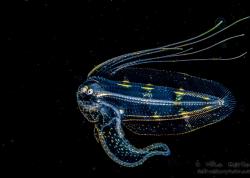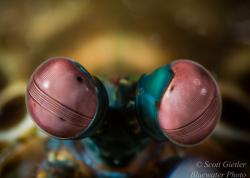It's All in the Flash
Birds do it, fish do it, and even humans beings do it. If you’re trying to attract a mate, sometimes it’s just impossible to find the right words, so body language has to do all the work. In the animal kingdom, the body language of your subject might be just a quick movement, subtle and even undetected to the human eye, while others flash gaudy and unmistakable displays (such as a peacock), which can be seen from deep space.
The best underwater photo strategy is always to take your time and observe your subject prior to attempting to photograph them. By doing this you will soon realize that it’s all about the flash!
Shooting animal behavior underwater is not unlike topside photography, where lens choice is critical for getting close enough to the subject without scaring them. Proper buoyancy, your hunting technique and stalking your subject play heavily into the end result, which is allowing the subject enough space to act naturally.
Different signals mean different things too, but I don’t speak blenny very well so deciphering their language is best left to the true experts. Regardless of what they are saying, the action and form of their communication is the action that you want to try and capture in your image. “Stop action photography” and “Peak of the action” are two phrases that I like to focus on when discussing this style of photography.
Remember this simple 3 step approach when preparing for your next outing Lights-Camera-Action!
Lights
Strobe lighting is very important for capturing well-lit action images. Don’t be afraid to adjust your strobe positioning at any time, and remember to increase your ISO and to turn down the strobe power to increase your recycle times. With faster flash recycle times, you can shoot a burst of images during peak action.
Camera
Camera settings cannot be overlooked for stop action photography or you will miss the shot. Shutter speeds must be fast enough to keep your image sharp and eliminate ambient light but still allow you to capture a strong, well-lit image. Your F-stop will vary depending on the depth of field you envision for the shot, as well as the distance light has to travel from strobe to subject back to camera.
Tip: Move your strobes closer to the subject so that the light has less distance to travel.
Action
Wait for it! Your subject will soon relax if your movements are minimized. If your subject becomes relaxed enough, it will begin its natural behavior. This is when you shoot, since capturing this behavior has the potential to become an award winning shot!
Techniques to Capture the Flashes

Sailfin Blennies (Emblemaria hypacanthus) are easily mistaken as a common blenny if the diver approaches quickly, as they tend to be on the skittish side. But when a diver approaches slowly and quietly, allowing the fish to relax, it will then begin to quickly raise and lower itself from its hidey hole, flashing its beautiful fin at the same time. It's best to watch and study the movements for a few moments before blasting away, as careless strobe flashes can and will scare the blennies back into the safety of their hole, resulting in a long waiting game.

In full regale - a Sailfin blenny will sit in the peak-a-boo position staring out of its hole for a very long time before it feels relaxed enough to expose itself. When it finally decides it is safe enough to begin signaling it will quickly emerge from its hole, extending its sailfin, and begin bobbing up and down rapidy. Remember: Lights, Camera, Action… be ready as this could be your only oportunity to get the shot!

Cephalopods are well known for signaling and flashing their colors as a danger signal or to mate with a prospective partner. The cranberry colors of the hunting cuttlefish might be showing a passive coloration to fool their prey or might be a warning for me to step back.

Hunting Blue Ring –There’s no mistaking the vibrant flash of the Blue-Ringed Octopus. When at rest the blue ring looks much like an ordinary octopus but once they become agitated or excited, the blue rings glow with blue indigo intensity. Their venomous bite is legendary and could also explain what their flashing signals are all about.
Octopus and other cephalopods have the unique ability to flash simultaneous messages showing aggression on one side (right) and a passive side on the other( left).
In this image the Blue Ring was hunting and moving from right to left, its leading side is lighter in coloration indicating a more passive coloration while the aggressive colors on the right protect it from a predator moving in from behind. This is commonly seen with mating where 2 males are attempting to mate with a single female.

Agitated by my strobe flashes, this blue ring flushes with a golden hue while its blue rings are vibrant and apparent. This octopus was actually hanging upside down under a coral head resting, until my modeling light disrupted it.

The Matote Blue Ring changes from a brownish sedate color that closely resembles the sand to a brilliant striped and nearly yellow coloration. The single blue ring on each side of its body also glows with Indigo-blue intensity.

Perhaps one of the most under photographed critters on all of the reefs is the flasher wrasse. They are extremely addictive to photograph once the subject is seen actually flashing. The fast movements are highlighted when they extend their pinnate dorsal spine and anal fins. Flasher wrasse become active in the late afternoons when the ambient light begins to fade, adding to the difficulty capturing a good shot, along with the fact that they don’t appreciate modeling lights.

The common lionfish makes for a brilliant image when they flash their spines and open up. This is a typical behavioral image documenting how lionfish use their fins to corral their prey or to signal each other.

Magnificent Shrimp Gobies (Flabellagobius sp.) use their fins for several reasons. One is of course to signal their buddy, but I have watched them actually cover the shrimp as they move up and down, cleaning out their hole, providing camouflage for their little buddy.
Lights-Camera-Action!
Remember to prepare before setting out to hunt these amazing creatures and others.Take your time and allow them to relax before blasting away with your strobes. Quantity doesn't mean quality when it comes to flashing behavior shots. Keep your eye in the viewfinder and your finger on the shutter release as the fast action never waits... it is always a surprise!
Even the most mundane creature can give you a big surprise, since its all in the flash!
Special thanks to Crystal Blue Resort
Gear:
Nikon D7100 in Sea & Sea MDX-D7100 housing
Nikon 105mm macro lens
Further Reading
RECOMMENDED ARTICLES
SUPPORT THE UNDERWATER PHOTOGRAPHY GUIDE:
The Best Service & Prices on u/w Photo Gear
 Visit Bluewater Photo & Video for all your underwater photography and video gear. Click, or call the team at (310) 633-5052 for expert advice!
Visit Bluewater Photo & Video for all your underwater photography and video gear. Click, or call the team at (310) 633-5052 for expert advice!
The Best Pricing, Service & Expert Advice to Book your Dive Trips
 Bluewater Travel is your full-service scuba travel agency. Let our expert advisers plan and book your next dive vacation. Run by divers, for divers.
Bluewater Travel is your full-service scuba travel agency. Let our expert advisers plan and book your next dive vacation. Run by divers, for divers.

































